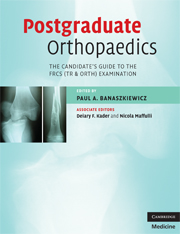Book contents
- Frontmatter
- Contents
- List of contributors
- Foreword by Mr Peter Gibson
- Preface
- Glossary
- Section 1 The FRCS (Tr & Orth) examination
- Section 2 The written paper
- Section 3 The clininicals
- Section 4 Adult elective orthopaedics oral
- Section 5 The hand oral
- Section 6 The paediatric oral
- Section 7 The trauma oral
- Section 8 The basic science oral
- Section 9 Miscellaneous topics
- 25 Candidates' accounts of the examination
- 26 Examination failure
- Index
- References
25 - Candidates' accounts of the examination
from Section 9 - Miscellaneous topics
Published online by Cambridge University Press: 22 August 2009
- Frontmatter
- Contents
- List of contributors
- Foreword by Mr Peter Gibson
- Preface
- Glossary
- Section 1 The FRCS (Tr & Orth) examination
- Section 2 The written paper
- Section 3 The clininicals
- Section 4 Adult elective orthopaedics oral
- Section 5 The hand oral
- Section 6 The paediatric oral
- Section 7 The trauma oral
- Section 8 The basic science oral
- Section 9 Miscellaneous topics
- 25 Candidates' accounts of the examination
- 26 Examination failure
- Index
- References
Summary
The exam has changed and evolved since these candidate accounts were first made. In particular, the short notes in the written paper have been superseded by the MCQ and EMI papers, but have been included here for completeness.
There are numerous candidate accounts of the examination floating around out in the orthopaedic domain. It is easy to get hold of them with a bit of detective work. When I sat the FRCS Orth examination these were very difficult to obtain. Initially these were secretly passed down from one trainee to another with many favours owed (a great deal of begging required) to obtain them and sworn secrecy not to pass them on to other candidates.
This moved up a level as these papers began to circulate amongst groups of trainees from various regions sitting the exam using them as a frame of reference for revision. After the group sat the exam they were then passed down to the trainees below them preparing to sit the examination.
These papers began to find their way on to the Internet and now BOTA has a dedicated examination site, which contains numerous past papers of candidates.
These candidate accounts can go on and on and miss the point. They give the candidate a much better guide as to which areas to concentrate revision on than the official syllabus (which can be somewhat vague in places). They are however just a frame of reference, albeit a very useful revision tool.
- Type
- Chapter
- Information
- Postgraduate OrthopaedicsThe Candidate's Guide to the FRCS (TR & Orth) Examination, pp. 569 - 586Publisher: Cambridge University PressPrint publication year: 2008



